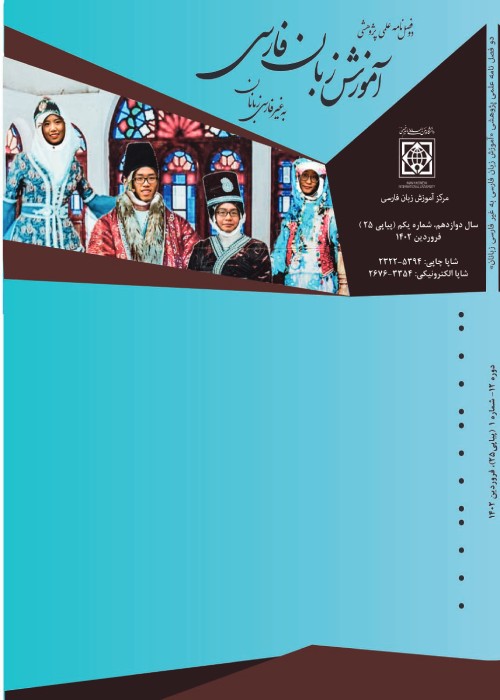Relationship Between Persian as Foreign Language Learners’ Anxiety, Enjoyment and Goal Orientation
Recent studies have suggested that the relationship between positive and negative emotions in foreign language classrooms depends on a set of learner-internal and learner-external factors. The present study adopted a Dynamic Systems Theory perspective in investigating the relationship between Persian as Foreign Language (PFL) learners’ Foreign Language Classroom Anxiety (FLCA), Foreign Language Enjoyment (FLE), and goal Orientation along with mastery/performance and approach/avoidance dichotomies. Participants were 72 Turkish students of medical sciences in Iran who took PFL classes for four months. Foreign language classroom Anxiety Scale (Horwitz, et al., 1986), Foreign Language Enjoyment Scale (Dewaele & MacIntyre, 2014), and Revised Achievement Goal Questionnaire (Elliot & Murayama, 2008) were used to collect data. Correlation and regression analyses were conducted to account for the dynamic relationship between the variables. Statistical analyses revealed a negative correlation between anxiety and enjoyment. Learners with performance-avoidance goals felt a high level of anxiety while performance-approach goals were negatively correlated with anxiety. Also, learners with mastery-avoidance goals experienced high level of enjoyment. Performance goal orientations predicted a total of 57 % of the variance in FLCA. Performance-avoidance goal had the strongest unique contribution to FLCA. The strongest unique predictor of FLE was the mastery-avoidance goal. The results generally confirm that mastery goals promote Persian learners’ emotional well-being while the role played by performance goals depends on the approach/avoidance dimension. It is suggested that the inconsistent findings regarding the relationships between emotional and motivational elements be accounted for by considering dynamicity between them. Extended Abstract Introduction A prominent course of research on SLA emotions involves the investigation into how positive and negative emotions co-inhabit in L2 classes and the way they interact with other variables in the SLA situation in affecting L2 acquisition. The dynamic properties of classroom emotions render them in an appropriate position to fit well into a dynamic systems perspective (Boudreau et al., 2018). Classroom emotions such as Foreign Language Classroom Anxiety (FLCA) and Foreign Language Enjoyment (FLE) are affected by both learner-related and situational variables. A promising course of research regarding emotional engagement in SL classroom emotions concerns the relevance of learner-internal and learner-external factors to FLE and FLCA. One of these learner-internal variables having received less attention is learners’ motivational orientation in terms of achievement goals. L2 learners’ type of achievement goal (Elliot & McGregor, 2001) can interact with their emotions in affecting learning achievement. The present study has two strains of research novelty. First, it studies the relationship between FLCA and FLE of Persian as a Foreign Language (PFL) learners for the first time. Furthermore, it examines the relationship between FLE and FLCA in reference to Persian learners’ type of achievement goal. Literature Review Anxiety and enjoyment have been regarded as the prototypical negative and positive emotions in foreign language situations. The relationship between these two emotions and their interactions with other variables in the foreign language classroom has recently been viewed as dynamic phenomena in SLA. The findings from empirical research have testified to the detrimental effect of the negative emotion and the enhancing impact of positive emotions on SL achievements (Horwitz, 2010). The majority of studies have reported a significant moderate negative correlation between FLCA and FLCE (Dewaele, et al., 2017; Dewaele & MacIntyre, 2014; Dewale & MacIntyre, 2019; Dewaele, Magdalena & Saito, 2019; Jiang & Dewaele, 2019; Li, 2018). However, recent research indicates that the SL learners’ anxiety and enjoyment do not vary independently from other variables in the SLA situation. Rather, the variation is determined by a set of learner-internal and learner-external factors that interact with foreign language emotions (Dewaele, et al., 2019). One of these variables is L2 learners’ Goal Orientation (Elliot & McGregor, 2001). The general implications of achievement goal theory have assumed that learners with performance goals experience higher levels of negative emotions while their mastery-goal counterparts experience more positive emotions in the process of learning (Huang, 2011; Linnenbrink-Garcia & Barger, 2014). As long as approach/avoidance dimensions of achievement goal are concerned, performance-approach goals are not associated with positive emotions whereas performance-avoidance goals are deemed to be negatively correlated with them, both of them showing a positive correlation with negative emotions (Linnenbrink & Pintrinch, 2002). There is sufficient evidence to support the positive effect of mastery goals on enjoyment and detrimental effect of performance goals on anxiety (Baudoin & Galand, 2020). Method Participants were 72 Turkish students of medical sciences in Iran who took PFL classes for four months. Foreign language classroom Anxiety Scale (Horwitz, et al., 1986), Foreign Language Enjoyment Scale (Dewaele & MacIntyre, 2014), and Revised Achievement Goal Questionnaire (Elliot & Murayama, 2008) were used to collect data. Correlation and regression analyses were conducted to account for the dynamic relationship between the variables. Results Statistical analyses revealed a negative correlation between anxiety and enjoyment though this correlation was supported only with a weak effect size (r2= .07), indicating that there was a negative and weak relationship between Persian learners’ positive and negative emotions. To further examine the dynamicity between FLCA and types of goal orientation, a regression analysis was conducted. Learners with performance-avoidance goals felt a high level of anxiety while performance-approach goals were negatively correlated with anxiety. Also, learners with mastery-avoidance goals experienced high level of enjoyment. A total of 57 % of the variance in FLCA was predicted by performance goal orientations, 42 % of which is the unique contribution of performance avoidance goals and 15 % is the unique role of performance-approach goals. Totally 52.5 % of the variance in PFL learners’ enjoyment was predicted by their mastery goal, of which 44.1 % belongs to mastery avoidance and 8.4 % originates from mastery approach goals. On the other hand, only 16.4 % of FLE variance is attributed to performance goals, of which 6.9 % is predicted by performance approach goal and 9.5 % is explained by performance avoidance goals. Discussion and Conclusion The negative correlation between anxiety and enjoyment obtained in most of the studies on a variety of foreign language classes which was also ratified in the current research for PFL learners can be interpreted as a proof for the facilitative effect of positive emotions such as enjoyment as supported by positive psychology (MacIntyre & Gregersen, 2012) and Broaden and Build theory (Fredrickson, 2001, 2003). The findings endorse the predictions of achievement goal theory that learners with performance goals experience more anxiety and those with mastery goals feel a higher level of enjoyment. However, the results concerning the role of approach/avoidance dimensions are inconsistent. This inconsistency can be accounted for when a Dynamic Systems Theory perspective is adopted. In this view, classroom emotions and achievement goals function in dynamic interaction with each other for the foreign language learner. Therefore, the emotional and motivational element should not be viewed in linear relationships with each other. Further studies concerning the dynamic interactions between different types of classroom emotions on the one hand and a set of situational and learner-related variables on the other hand are required by resorting to novel methodological techniques that can take dynamicity between variables into account. Resorting to such methods as idioymamic method (Boudreau, et al., 2018) as well as structural modeling can provide better opportunities of accounting for the dynamic relations so that a more lucid image of foreign language classroom emotions is achieved.
- حق عضویت دریافتی صرف حمایت از نشریات عضو و نگهداری، تکمیل و توسعه مگیران میشود.
- پرداخت حق اشتراک و دانلود مقالات اجازه بازنشر آن در سایر رسانههای چاپی و دیجیتال را به کاربر نمیدهد.



